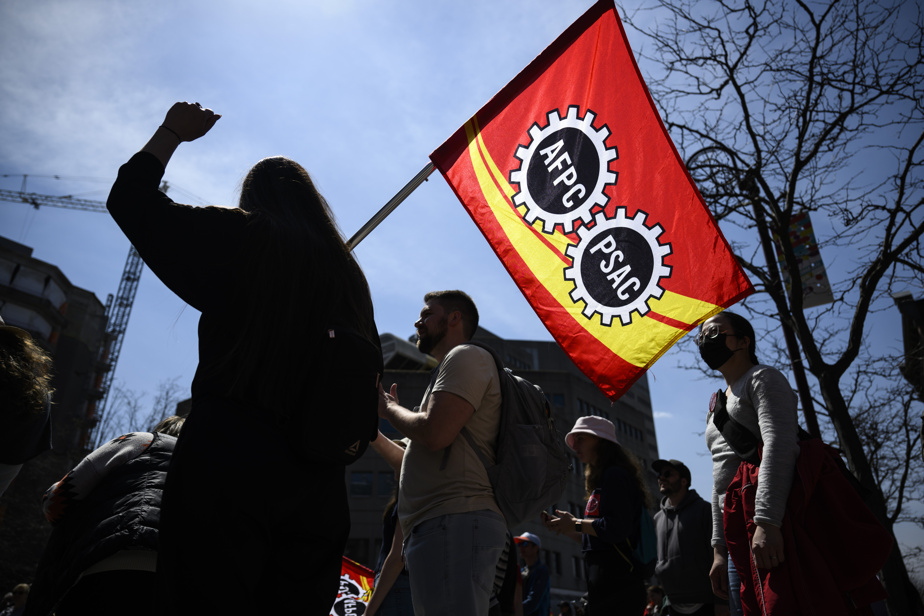(OTTAWA) The federal government on Friday tabled a new offer to the Public Service Alliance of Canada for the renewal of collective agreements as thousands of federal workers remained on strike for a tenth consecutive day.
The union and a spokeswoman for Treasury Board President Mona Fortier confirmed there had been a new offer, in the first sign of progress since the union said talks had reached an impasse on Wednesday. .
Ms. Fortier’s publicist, Monica Granados, called it a “global offer,” but provided no further details.
In a written statement, the union confirmed it had received the offer as talks resumed on Friday.
“We hope to continue to negotiate this weekend in order to reach a fair agreement,” the statement read.
Prime Minister Justin Trudeau said Friday the government was making “serious offers” to end the strike by the largest public sector union.
The collective agreements affect 155,000 federal workers in total, but the government has considered about 46,000 of them essential workers who do not participate in job action.
The PSAC collective agreements expired in 2021.
Earlier this week, PSAC National President Chris Aylward said he wanted Mr. Trudeau to be directly involved in the negotiations, which he said had reached an impasse because the government had failed. no move since his last offer of a 9% pay rise over three years.
Mr. Trudeau, who was in New York this week for a trade-focused visit, said he was involved in the negotiations.
“Since the beginning, I have been involved in the negotiation strategies, in the engagement that we have around the negotiation table,” he said, answering a question from a journalist during a press conference.
He said he was convinced that the strike could end through a negotiated agreement. The government could end the strike with back-to-work legislation, but Liberal ministers refused even to answer a question about using such a tool.
“I have confidence in the negotiation process. We will continue to watch over that, Mr. Trudeau said. We know that our negotiators are making serious offers. »
In a Twitter post Friday morning, Treasury Board President Mona Fortier said the two sides were talking at the negotiating table.
“The government is committed to negotiating a fair, competitive and reasonable deal,” she said.
Ms. Fortier has repeatedly said this is the salary offer recommended by the Public Interest Commission, a committee appointed last year by the Industry Labor Relations and Employment Commission. federal public to help the two parties reach an agreement.
The union originally asked for 13.5% over the same period and while it says it has adjusted that demand, it has not specified what the new proposal is.
Early Friday, pickets were a little thinner in downtown Ottawa than they had been earlier in the week, when union members flooded the parliamentary precinct in an attempt to step up the direct impact of the strike.
A handful of workers remained outside the doors of many federal office buildings, limiting entry to one person every five minutes.
But a larger rally took place on one of the bridges that cross the Ottawa River to Gatineau, Que., where PSAC members also marked the National Day of Mourning for workers killed or injured in the work.
“We’re taking the bridge,” chanted a large group of strikers as they crossed it.
Strikers gathered early Friday morning in front of the Service Canada building located on Place de la Cité, in Sherbrooke, to take buses that were to take them to the Stanstead border crossing, in Estrie, to demonstrate on the tenth day of their disengagement.
This small Canada Border Services Agency (CBSA) post, which is open at all times, allows you to cross the few meters that separate Stanstead from the municipality of Derby Line, in the State of Vermont.
This demonstration was to be less imposing than that of the day before, when many striking union members demonstrated near the border crossing of Saint-Bernard-de-Lacolle, in Montérégie, usually one of the busiest in Canada. Several police officers from the Sûreté du Québec (SQ) were also on the scene; they formed a human barrier limiting the movements of the demonstrators.
The members of the Public Service Alliance of Canada were on Friday for their tenth day of walkout. The labor dispute affects some 155,000 workers, about a third of the entire federal public service, including 35,000 Canada Revenue Agency (CRA) workers who are separately negotiating their collective agreements.
Ms. Fortier said in an open letter earlier this week that she offered to do a joint review of the telecommuting policy with the unions.
Jennifer Carr, president of the Professional Institute of the Public Service of Canada, said it was a good start, but it was not enough.
“We need a binding commitment in a collective agreement because we’ve seen too many cases of the employer abandoning their promises or ignoring the process after signing a memorandum of understanding with us,” she said. declared.
Ms Carr claimed the government’s consultation on the back-to-office directive was “appalling” and that it was not even in line with the advice of the government’s own advisers.
As the strike continues, Canadians face a wide range of disruptions to federal services, including the inability to process immigration and passport applications.

